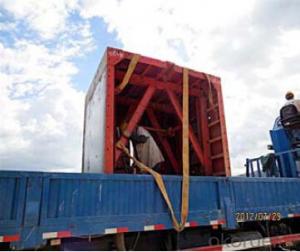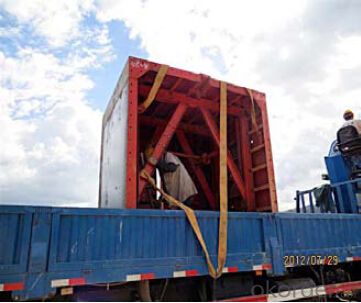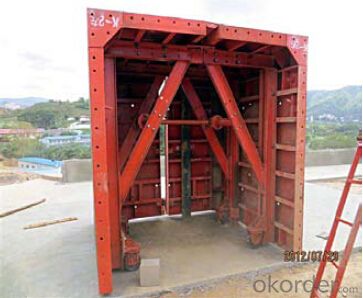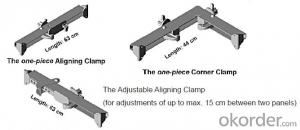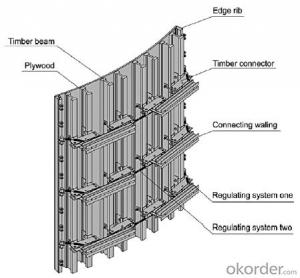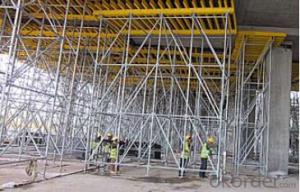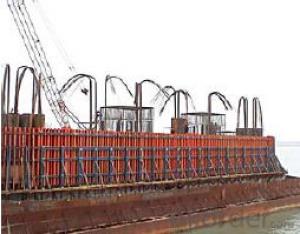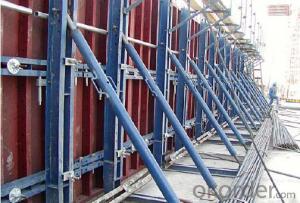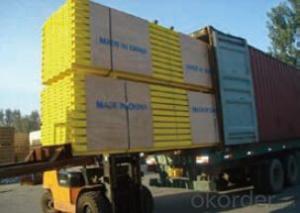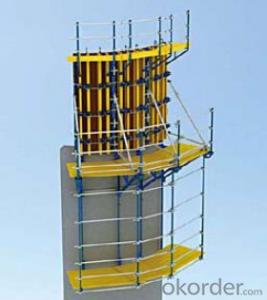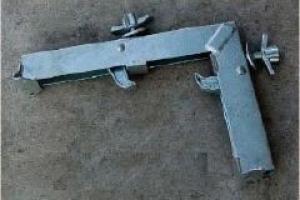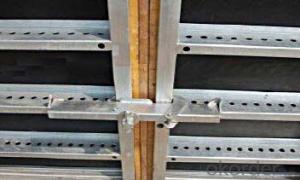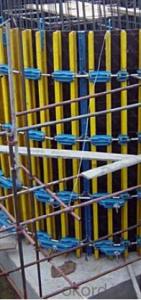Steel Tunnel for formwork and scaffolding system
- Loading Port:
- Tianjin
- Payment Terms:
- TT OR LC
- Min Order Qty:
- 50 m²
- Supply Capability:
- 1000 m²/month
OKorder Service Pledge
Quality Product, Order Online Tracking, Timely Delivery
OKorder Financial Service
Credit Rating, Credit Services, Credit Purchasing
You Might Also Like
Building Tunnel Formwork:
A compositional steel formwork system mainly used in the building which has regular structure
without beams, the excellent formwork system can make the integral pouring for the wall & slab
easily achieved.
Characteristics:
◆ High stiffness, make perfect shape for concrete.
◆ Easy operation, save labor and force.
◆ Fast forming, repeatedly turnover.
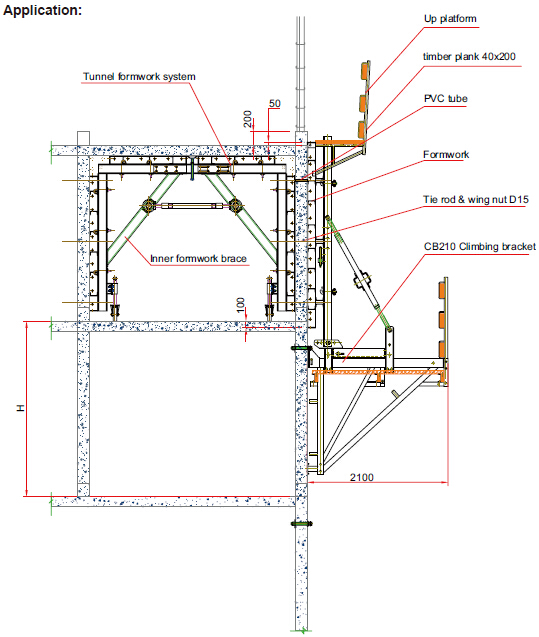
- Q: How does steel formwork perform in seismic zones?
- Steel formwork performs well in seismic zones due to its high strength and durability. Steel is known for its excellent load-bearing capacity and resistance to bending and shearing forces, making it suitable for withstanding the intense shaking and vibrations caused by earthquakes. In seismic zones, the ground experiences significant movement during an earthquake, which can put immense pressure on the formwork system. Steel formwork, being rigid and robust, is able to withstand these forces without any significant deformation or damage. This ensures the stability and integrity of the structure during and after the seismic event. Additionally, steel formwork offers flexibility in design and construction, allowing for the creation of reinforced concrete structures that are better equipped to handle seismic loads. The use of steel formwork enables the incorporation of additional reinforcement elements, such as steel bars and mesh, which enhance the overall strength and ductility of the structure. This helps in dissipating the energy generated by seismic forces and reducing the risk of structural failure. Moreover, steel formwork is reusable and can be easily dismantled and reassembled, making it a cost-effective and sustainable choice for construction in seismic zones. This flexibility allows for the quick repair and reconstruction of structures in the event of earthquake damage, minimizing downtime and ensuring the safety of occupants. Overall, steel formwork is a reliable and resilient choice for construction in seismic zones. Its strength, durability, and flexibility make it well-suited to withstand the forces generated by earthquakes, ensuring the safety and stability of structures in these high-risk areas.
- Q: Can steel formwork be used for structures with high impact resistance requirements?
- Yes, steel formwork can be used for structures with high impact resistance requirements. Steel is known for its strength and durability, making it suitable for withstanding high impact loads. It has a high strength-to-weight ratio, providing excellent resistance against impact forces. Steel formwork systems are commonly used in construction projects that require structures to withstand heavy loads or potential impacts, such as bridges, tunnels, and high-rise buildings. Additionally, steel formwork can be easily fabricated and assembled, allowing for quick and efficient construction of structures with high impact resistance requirements.
- Q: Can steel formwork be used for projects with limited formwork stripping time?
- Yes, steel formwork can be used for projects with limited formwork stripping time. Steel formwork is known for its durability and strength, allowing it to withstand the pressure and load of concrete during the curing process. Additionally, steel formwork is reusable and can be quickly dismantled, making it suitable for projects with tight schedules where formwork stripping needs to be done promptly.
- Q: What are the different components of a steel formwork system?
- A steel formwork system typically consists of several components that work together to create a sturdy and reliable structure for concrete casting. These components include: 1. Panels: Steel formwork panels are the main part of the system and are usually made of high-quality steel sheets. These panels are designed to provide a smooth and even surface for concrete pouring. They come in different sizes and shapes to accommodate various types of construction projects. 2. Connectors: Connectors are used to join the panels together and ensure they remain in place during concrete pouring. These connectors can be in the form of clamps, bolts, or pins, and they help to create a tight and secure fit between the panels. 3. Props: Props or vertical supports are used to provide additional support and stability to the formwork system. They are designed to withstand the weight of the concrete and prevent the formwork from collapsing. Props can be adjustable in height, allowing for flexibility in formwork design. 4. Beams: Steel beams are used to support the weight of the formwork system and transfer it to the ground. These beams are typically placed horizontally and provide a strong framework for the panels and other components to rest on. They are often adjustable in length to accommodate different project requirements. 5. Bracing: Bracing elements, such as diagonal struts and cross braces, are used to reinforce the formwork system and prevent it from buckling or deforming under the pressure of the concrete. These bracing components are strategically placed to distribute the load evenly and enhance the overall stability of the system. 6. Accessories: There are various accessories that can be used to enhance the functionality and efficiency of a steel formwork system. These include corner pieces, wedge bolts, release agents, and chamfer strips. These accessories help to improve the overall performance of the formwork system and ensure smooth and accurate concrete casting. Overall, a steel formwork system is a comprehensive solution for creating strong and durable concrete structures. Its different components work together to provide stability, flexibility, and ease of use, making it a preferred choice in various construction projects.
- Q: Can steel formwork be used for projects with high groundwater levels?
- Yes, steel formwork can be used for projects with high groundwater levels. Steel formwork is known for its durability and resistance to water, making it suitable for construction projects in areas with high groundwater levels. Its robustness and waterproof properties allow it to withstand the pressure and moisture from the groundwater, ensuring the stability and integrity of the structure being built.
- Q: How is steel formwork secured to the ground?
- Steel formwork is secured to the ground through several methods to ensure stability and safety during the construction process. One common way to secure steel formwork is by using ground anchors. These anchors are usually made of steel or concrete and are driven into the ground at regular intervals along the perimeter of the formwork. The anchors are then connected to the formwork using steel rods or cables, providing a strong and secure attachment to the ground. Another method of securing steel formwork to the ground is by using steel stakes. These stakes are driven into the ground at regular intervals, and the formwork is then attached to the stakes using various clamps or brackets. This method is commonly used when the ground is not suitable for using ground anchors, such as in rocky or uneven terrains. In addition to ground anchors and stakes, steel formwork can also be secured to the ground by using concrete footing or foundation. This involves pouring concrete footings or foundations at regular intervals along the perimeter of the formwork. The formwork is then attached to the concrete using bolts or other fasteners, providing a solid and stable connection. The method of securing steel formwork to the ground may vary depending on the specific requirements of the construction project and the type of ground conditions. It is essential to follow the manufacturer's instructions and consult with structural engineers to ensure the proper installation and secure attachment of the formwork to the ground.
- Q: How does steel formwork affect the overall construction site organization?
- Steel formwork can have a significant impact on the overall organization of a construction site. Firstly, steel formwork is known for its durability and reusability, which means it can be used multiple times for different projects. This allows for better planning and scheduling of construction activities, as the availability of formwork is more predictable and reliable. Additionally, steel formwork is known for its precision and accuracy, which leads to better quality construction. This can result in fewer reworks and delays, as the formwork ensures that concrete is poured in the right place and to the correct dimensions. Consequently, the overall construction process becomes more efficient, allowing for better organization and coordination of various trades and activities on the site. Steel formwork also offers flexibility in design and construction. It can be easily adjusted and modified to accommodate changes in the project, such as alterations in the shape or size of concrete elements. This adaptability reduces the need for additional materials and resources, which can streamline the organization of the construction site and minimize waste. Furthermore, steel formwork is known for its strength and stability. This allows for taller and larger concrete structures to be constructed, which can have implications for the overall layout and organization of the site. For example, it may require additional crane or lifting equipment to handle the heavier and larger formwork components. This necessitates careful planning and coordination to ensure that the site is properly organized to accommodate these requirements. In summary, steel formwork positively impacts the overall organization of a construction site by providing durability, precision, flexibility, and strength. These attributes contribute to better planning, scheduling, and coordination of construction activities, resulting in improved efficiency, quality, and adaptability.
- Q: Steel formwork in the construction project, after the completion of concrete pouring, the wall surface from the powder seriously how to deal with?
- Two possibilities, one is the vibration of concrete and other factors to produce concrete segregation; the two is the ratio of the concrete itself (see a similar situation, pumping agent over)
- Q: How does steel formwork compare to timber formwork?
- Steel formwork is generally considered to be superior to timber formwork in terms of durability, strength, and reusability. Steel formwork has a longer lifespan, can withstand higher pressures and loads, and requires less maintenance compared to timber formwork. Additionally, steel formwork provides better dimensional accuracy and consistency, resulting in smoother and more uniform concrete surfaces. While timber formwork may be less expensive and easier to handle, steel formwork offers numerous advantages that make it a preferred choice in many construction projects.
- Q: What are the considerations when designing steel formwork for underground structures?
- Several factors must be taken into account when designing steel formwork for underground structures. Firstly, the formwork must be able to withstand the pressure exerted by the surrounding soil. Underground structures face significant lateral and vertical loads, so the formwork must resist these forces without deforming or collapsing. Steel, with its high strength and rigidity, is an ideal material for this purpose. Secondly, the formwork should be designed for easy installation and removal. Underground construction presents challenges such as limited access and confined working spaces. Therefore, the formwork system should be modular and adjustable to fit different shapes and sizes of underground structures. This would allow for efficient construction and minimize the time and effort required for formwork installation and removal. Additionally, the formwork design should consider the ease of concrete pouring and curing. Proper placement of tie rods, formwork joints, and other structural elements is crucial to ensure smooth and even flow of concrete throughout the structure. The formwork system should also provide for ventilation and drainage to prevent water accumulation or air pockets that could compromise the structure's integrity. Moreover, safety is of utmost importance in designing steel formwork for underground structures. The formwork system should incorporate safety features like guardrails and access platforms to ensure a secure working environment for construction workers. The design should also minimize manual handling by utilizing lifting and handling equipment, reducing the risk of accidents or injuries during formwork installation and dismantling. Lastly, the formwork design should consider the project's budget and schedule constraints. While steel formwork may be more expensive than other types, cost-effective design solutions should be explored without compromising safety and performance. The formwork system should also be designed for reusability, allowing for multiple applications and reducing overall project costs. In conclusion, designing steel formwork for underground structures involves careful consideration of factors like strength, durability, ease of installation, concrete pouring, safety, and cost-effectiveness. By addressing these considerations, designers can ensure the successful construction of underground structures that meet project requirements and withstand the challenges of underground environments.
Send your message to us
Steel Tunnel for formwork and scaffolding system
- Loading Port:
- Tianjin
- Payment Terms:
- TT OR LC
- Min Order Qty:
- 50 m²
- Supply Capability:
- 1000 m²/month
OKorder Service Pledge
Quality Product, Order Online Tracking, Timely Delivery
OKorder Financial Service
Credit Rating, Credit Services, Credit Purchasing
Similar products
Hot products
Hot Searches
Related keywords
